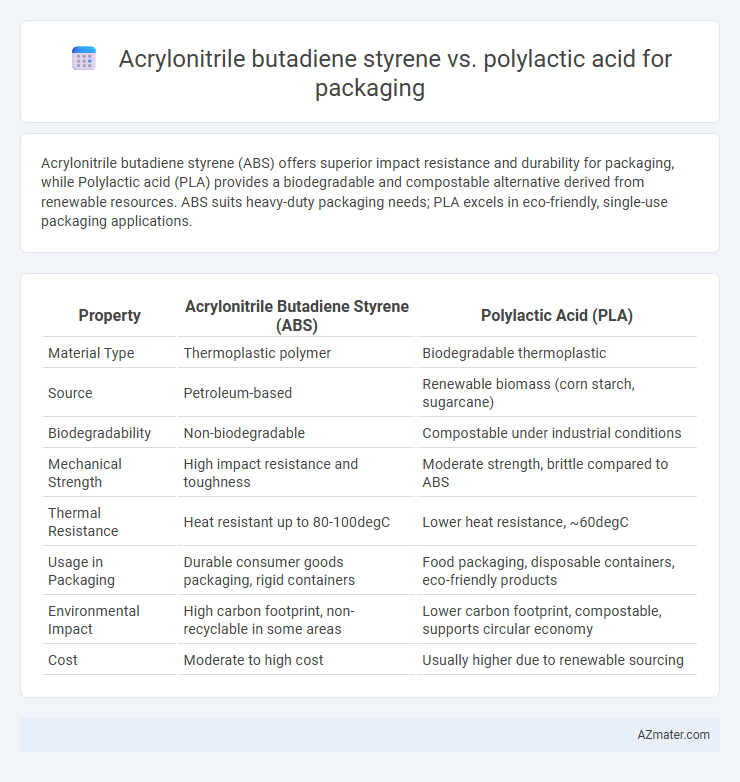Acrylonitrile butadiene styrene (ABS) offers superior impact resistance and durability for packaging, while Polylactic acid (PLA) provides a biodegradable and compostable alternative derived from renewable resources. ABS suits heavy-duty packaging needs; PLA excels in eco-friendly, single-use packaging applications.
Table of Comparison
| Property | Acrylonitrile Butadiene Styrene (ABS) | Polylactic Acid (PLA) |
|---|---|---|
| Material Type | Thermoplastic polymer | Biodegradable thermoplastic |
| Source | Petroleum-based | Renewable biomass (corn starch, sugarcane) |
| Biodegradability | Non-biodegradable | Compostable under industrial conditions |
| Mechanical Strength | High impact resistance and toughness | Moderate strength, brittle compared to ABS |
| Thermal Resistance | Heat resistant up to 80-100degC | Lower heat resistance, ~60degC |
| Usage in Packaging | Durable consumer goods packaging, rigid containers | Food packaging, disposable containers, eco-friendly products |
| Environmental Impact | High carbon footprint, non-recyclable in some areas | Lower carbon footprint, compostable, supports circular economy |
| Cost | Moderate to high cost | Usually higher due to renewable sourcing |
Introduction to ABS and PLA in Packaging
Acrylonitrile butadiene styrene (ABS) is a robust, impact-resistant thermoplastic widely used in packaging for its durability and excellent mechanical properties. Polylactic acid (PLA) is a biodegradable, bio-based polymer derived from renewable resources like corn starch, favored in packaging for its compostability and reduced environmental footprint. ABS offers superior strength and chemical resistance, while PLA provides eco-friendly advantages, making both materials key choices depending on packaging sustainability and performance requirements.
Material Overview: Acrylonitrile Butadiene Styrene (ABS)
Acrylonitrile Butadiene Styrene (ABS) is a durable thermoplastic known for its impact resistance, toughness, and chemical stability, making it ideal for packaging applications requiring high strength and protection. ABS offers excellent dimensional stability and resistance to heat and moisture, which ensures reliable performance during transportation and storage. Its ability to be easily molded and blended with additives enhances barrier properties, making it a versatile choice over Polylactic Acid (PLA) in packaging scenarios that demand robustness and longevity.
Material Overview: Polylactic Acid (PLA)
Polylactic Acid (PLA) is a biodegradable thermoplastic derived from renewable resources such as corn starch or sugarcane, making it an eco-friendly alternative to traditional petroleum-based plastics like Acrylonitrile Butadiene Styrene (ABS). PLA offers excellent clarity and rigidity, making it suitable for packaging applications that require transparency and moderate strength. Its compostable nature under industrial conditions positions PLA as a sustainable choice for packaging materials with reduced environmental impact compared to non-biodegradable polymers.
Mechanical Properties Comparison
Acrylonitrile butadiene styrene (ABS) exhibits superior impact resistance and tensile strength compared to polylactic acid (PLA), making it more suitable for applications requiring durability and toughness in packaging. ABS maintains high mechanical stability under varying temperatures, whereas PLA tends to be more brittle and has lower thermal resistance, limiting its use in high-impact or high-stress environments. The higher elongation at break and impact strength of ABS ensures better protection for packaged goods, while PLA's mechanical properties favor compostable and biodegradable packaging solutions.
Environmental Impact and Sustainability
Acrylonitrile butadiene styrene (ABS) is a petroleum-based thermoplastic known for its durability but poses significant environmental challenges due to its non-biodegradability and difficulty in recycling. Polylactic acid (PLA), derived from renewable resources like corn starch, offers a more sustainable alternative with biodegradability and compostability under industrial conditions, reducing landfill impact. Despite PLA's lower carbon footprint and reduced reliance on fossil fuels, its limited heat resistance and current industrial composting infrastructure can affect widespread adoption in packaging applications.
Cost Analysis: ABS vs PLA
Acrylonitrile butadiene styrene (ABS) typically incurs higher costs than polylactic acid (PLA) due to its petroleum-based origin and complex manufacturing process, resulting in greater energy consumption and production expenses. PLA, derived from renewable resources like corn starch, benefits from lower raw material costs and biodegradability, making it a cost-effective option for sustainable packaging. When selecting materials for packaging, the balance between ABS's durability and PLA's cost-efficiency and environmental advantages is critical for optimizing overall production budgets.
Processing and Manufacturing Considerations
Acrylonitrile butadiene styrene (ABS) offers excellent impact resistance and thermal stability, making it suitable for injection molding and extrusion in packaging applications, with a processing temperature range of 200-250degC. Polylactic acid (PLA), derived from renewable resources, requires lower processing temperatures around 170-230degC and is best processed through injection molding or thermoforming, but it is more sensitive to moisture and requires controlled drying before manufacturing. ABS provides more robust mechanical properties during manufacturing, while PLA's biodegradability poses challenges for long-term thermal and mechanical stability in packaging production.
Packaging Performance and Durability
Acrylonitrile butadiene styrene (ABS) offers superior impact resistance and durability, making it ideal for packaging that requires high mechanical strength and protection during transport. Polylactic acid (PLA), a biodegradable polymer, provides excellent clarity and is suitable for short-term packaging applications but has lower heat resistance and mechanical toughness compared to ABS. ABS outperforms PLA in packaging performance under stress and harsh conditions, while PLA excels in eco-friendly, compostable packaging solutions with moderate durability.
Regulatory and Safety Aspects
Acrylonitrile butadiene styrene (ABS) is widely used in packaging due to its high impact resistance but faces regulatory scrutiny because of potential chemical leaching and limited biodegradability. Polylactic acid (PLA), derived from renewable resources, is favored for its compostability and compliance with FDA and EU food contact regulations, promoting safety in food packaging. Regulatory frameworks increasingly prioritize PLA for sustainable packaging solutions while requiring thorough safety evaluations for ABS in direct food contact applications.
Conclusion: Choosing the Right Material for Packaging
Acrylonitrile butadiene styrene (ABS) offers superior impact resistance and durability, making it ideal for protective packaging applications requiring toughness and temperature resistance. Polylactic acid (PLA) stands out for its biodegradability and renewable origin, suitable for eco-friendly packaging solutions prioritizing sustainability. Selecting the right material depends on balancing mechanical performance needs with environmental impact considerations for optimal packaging effectiveness.

Infographic: Acrylonitrile butadiene styrene vs Polylactic acid for Packaging
 azmater.com
azmater.com